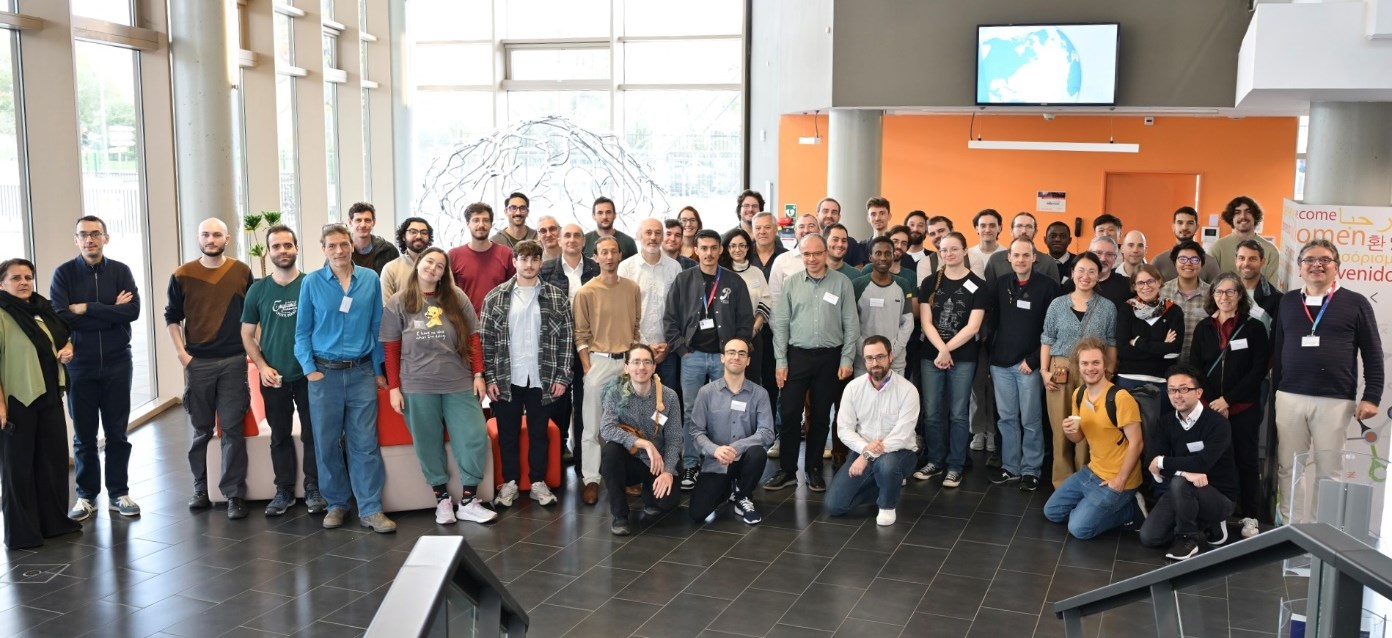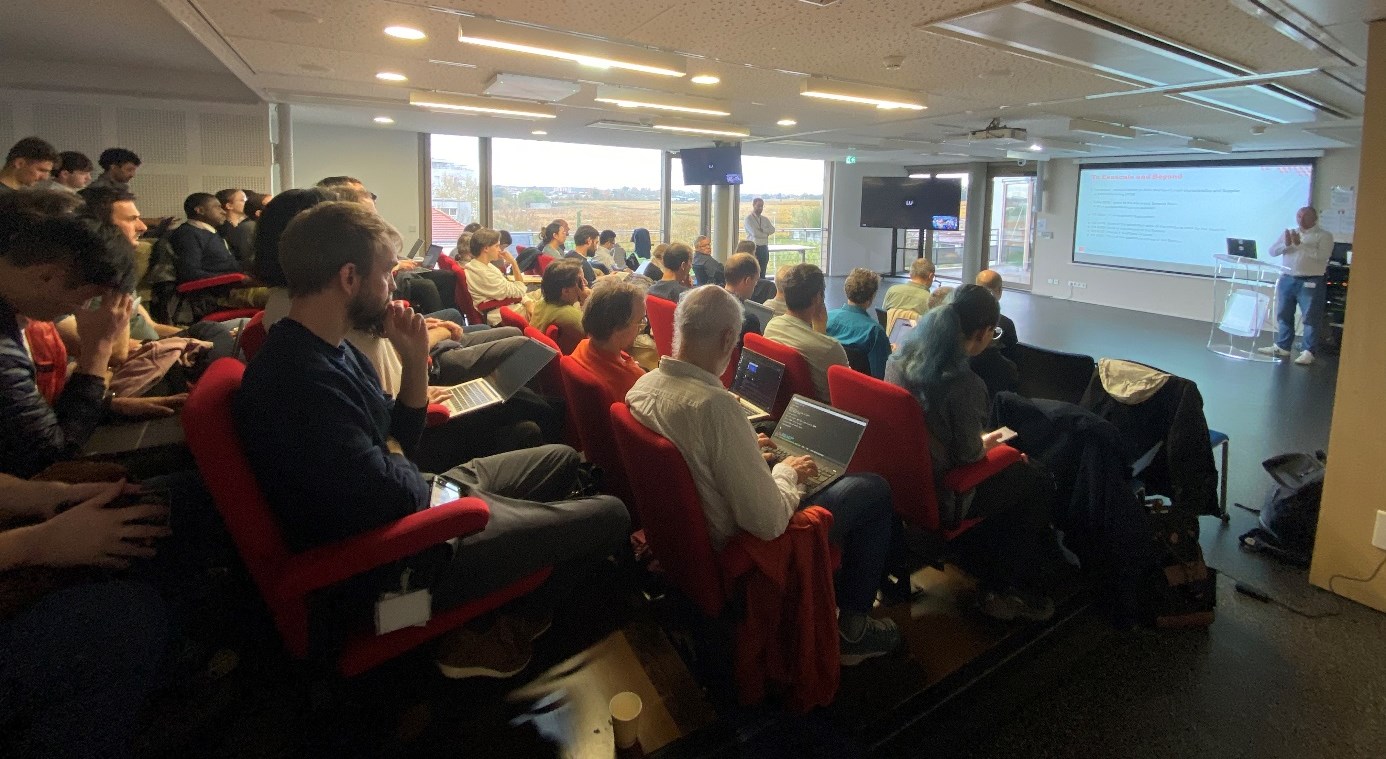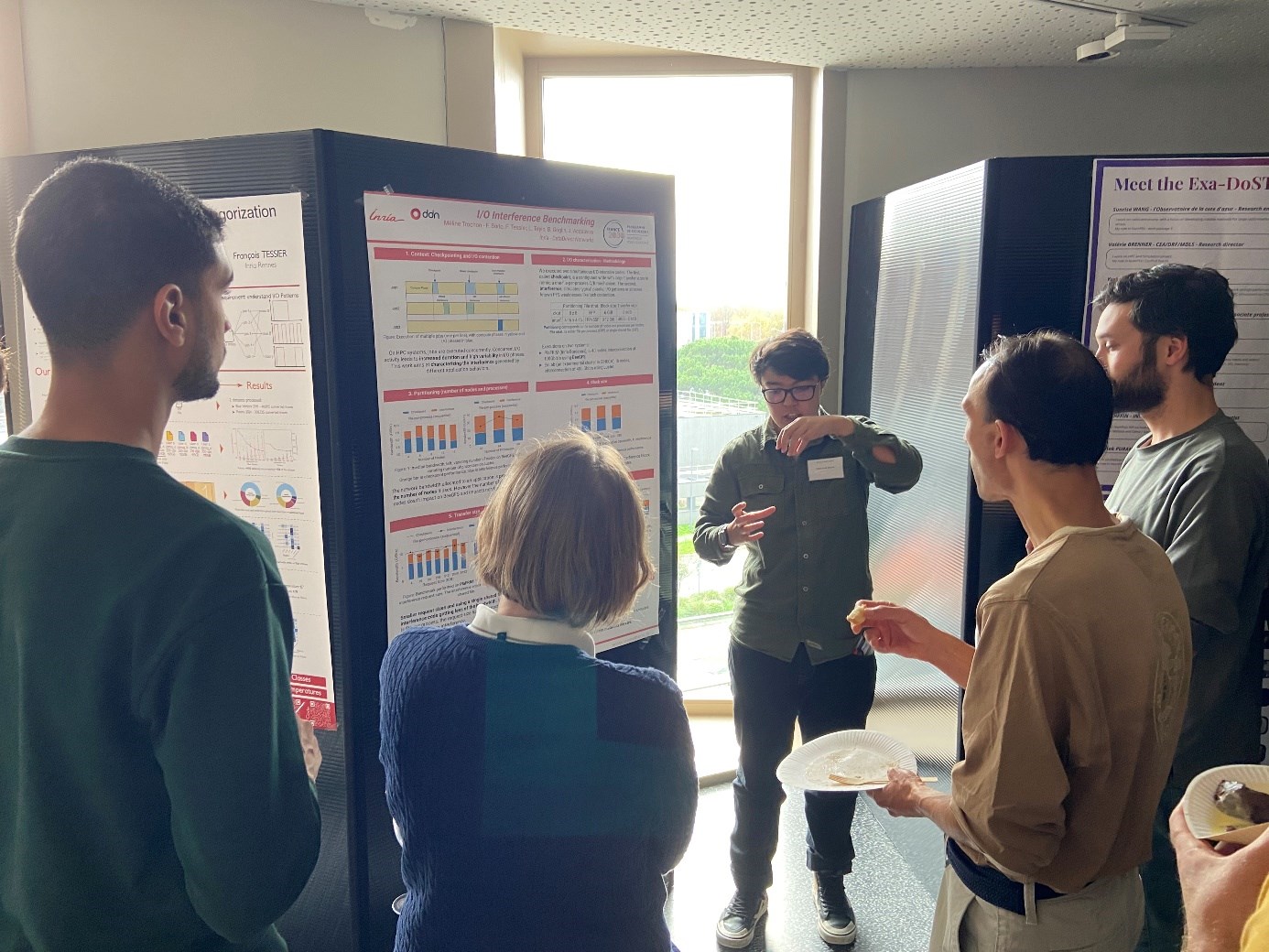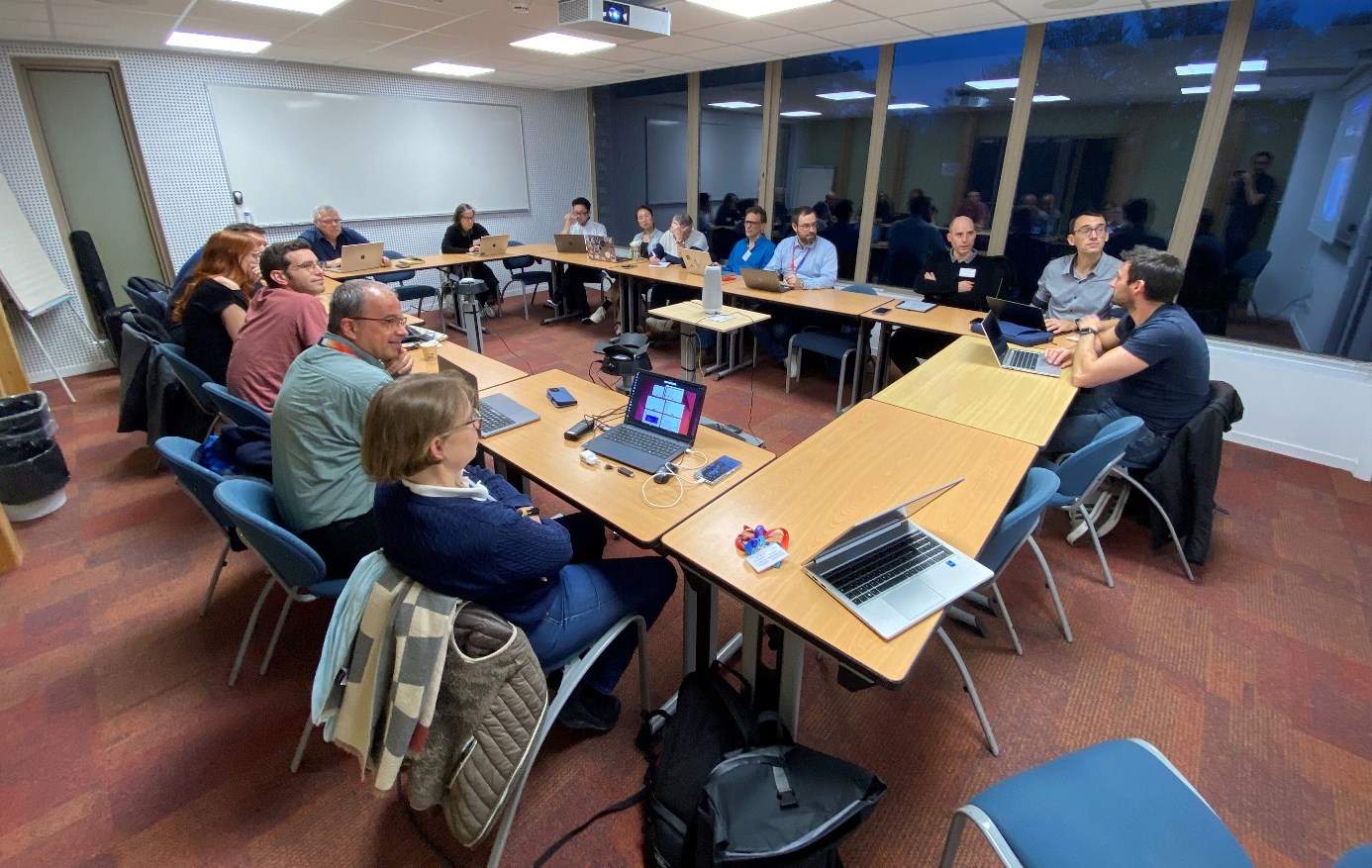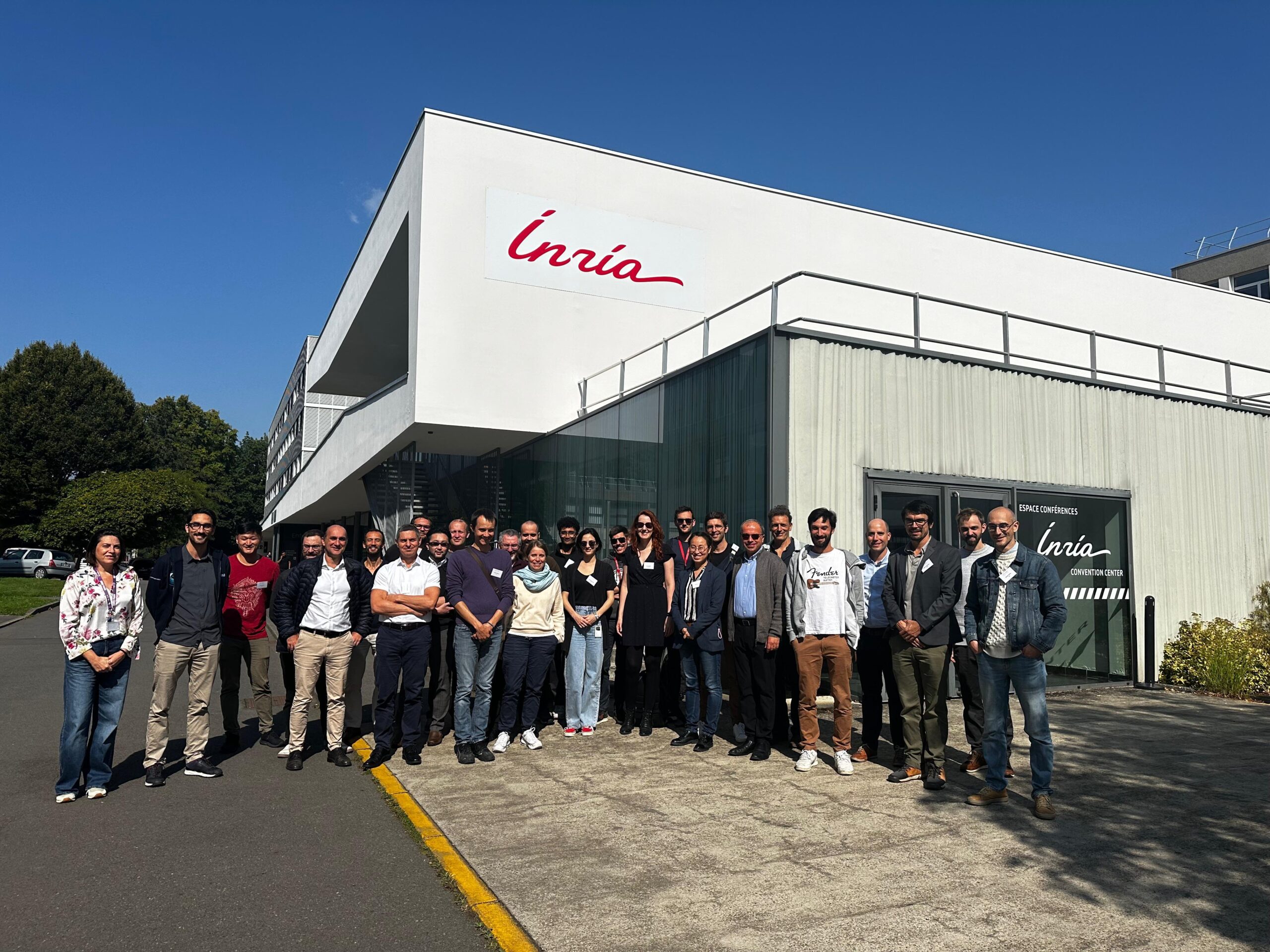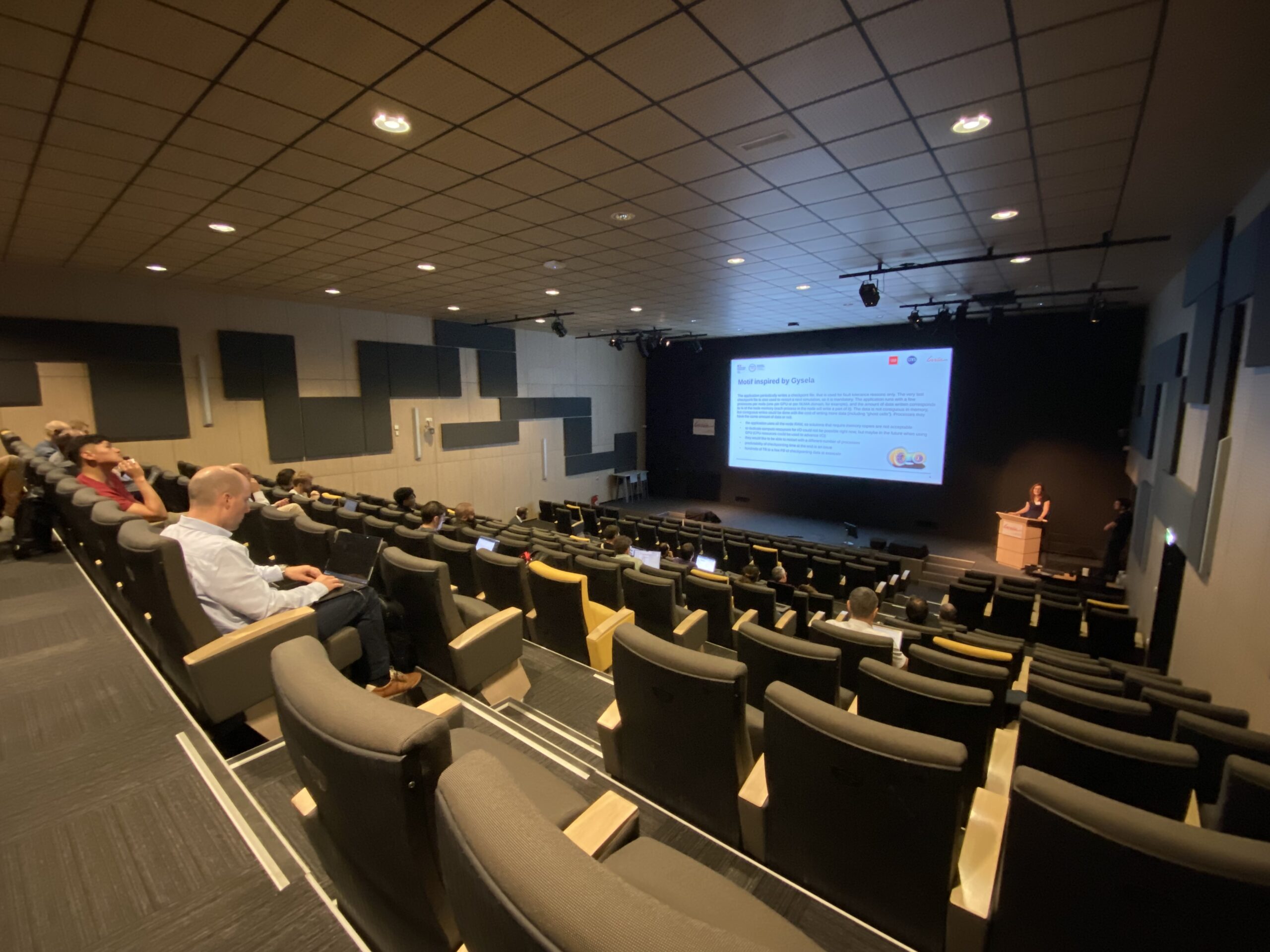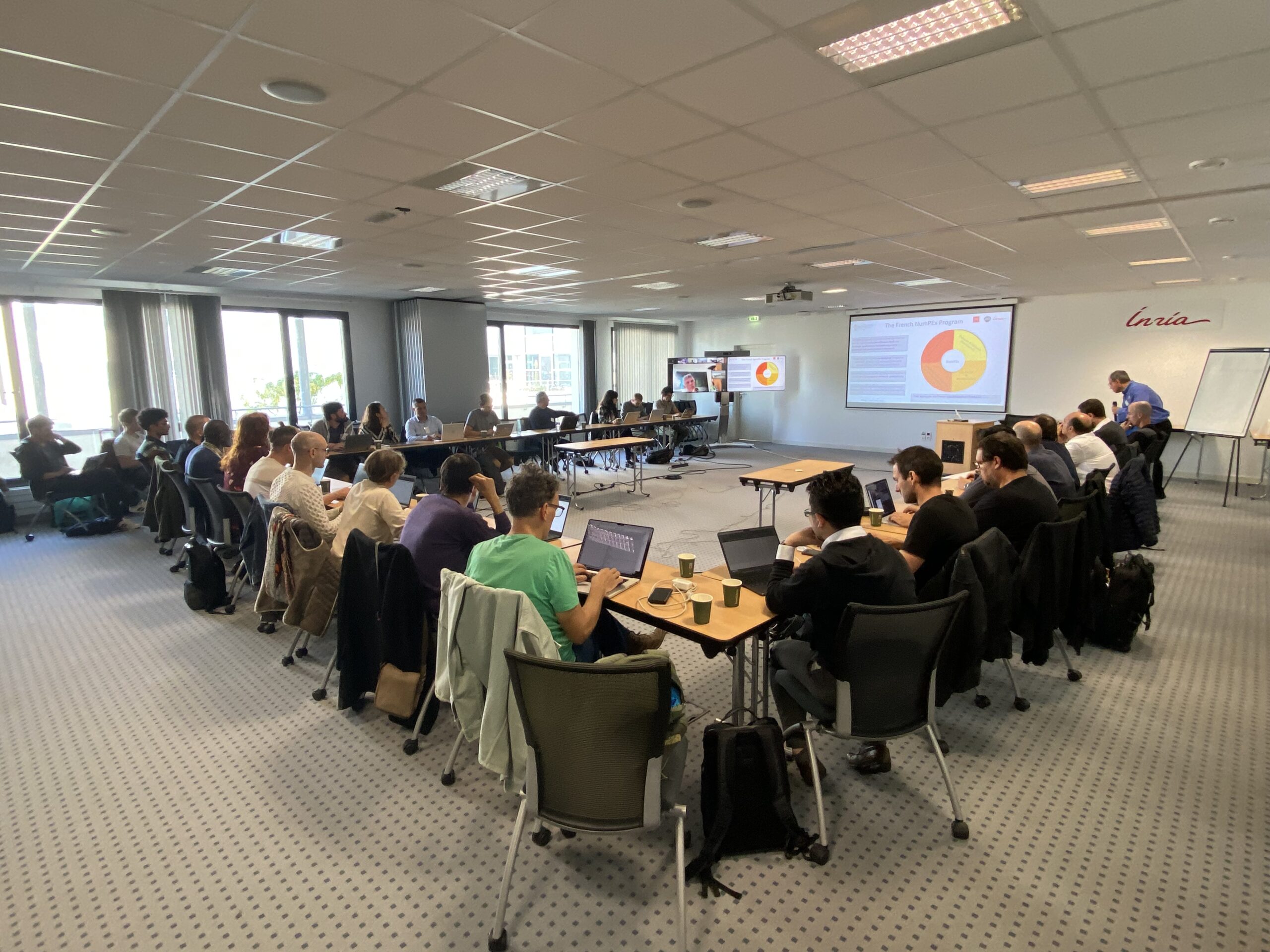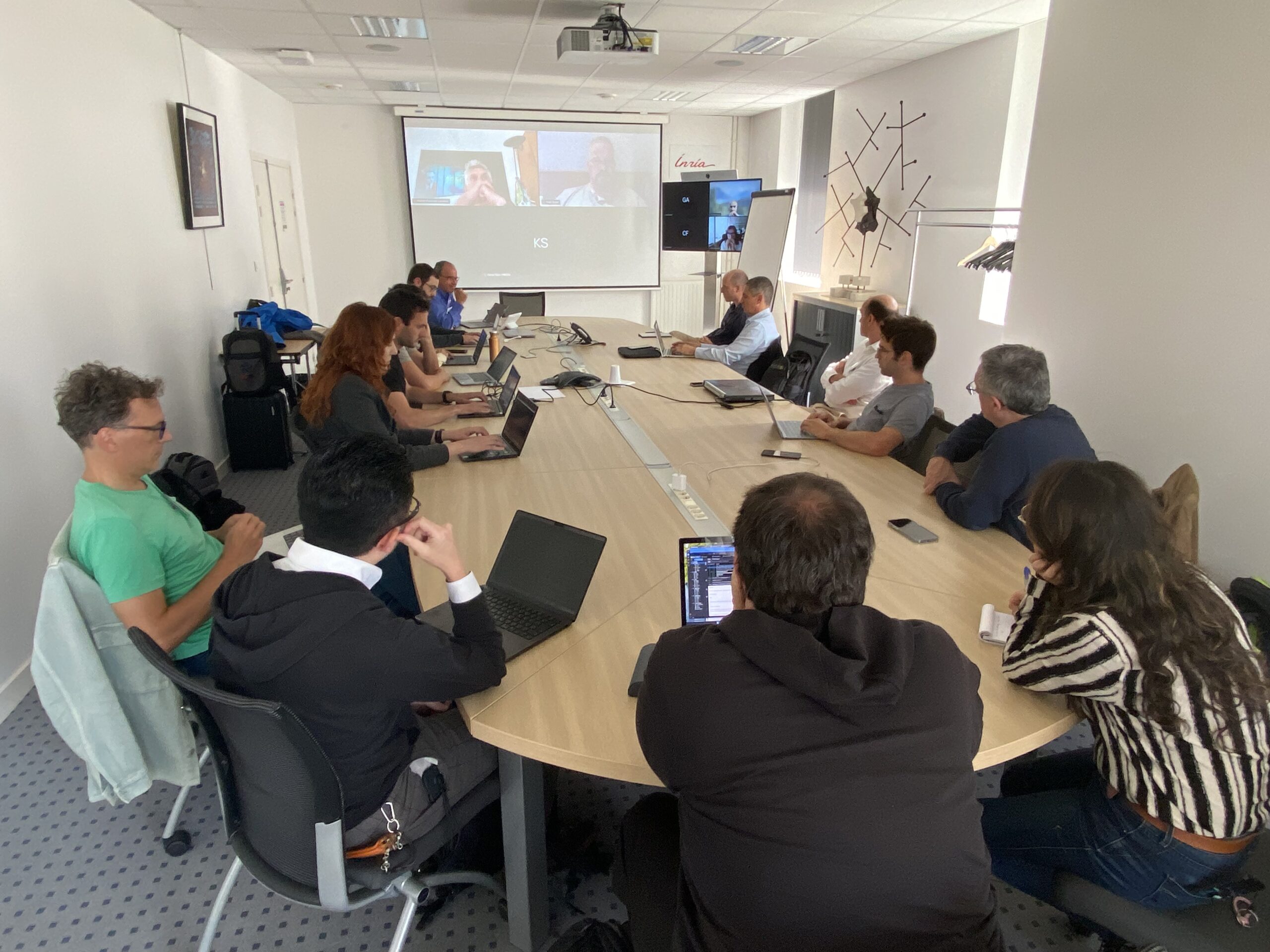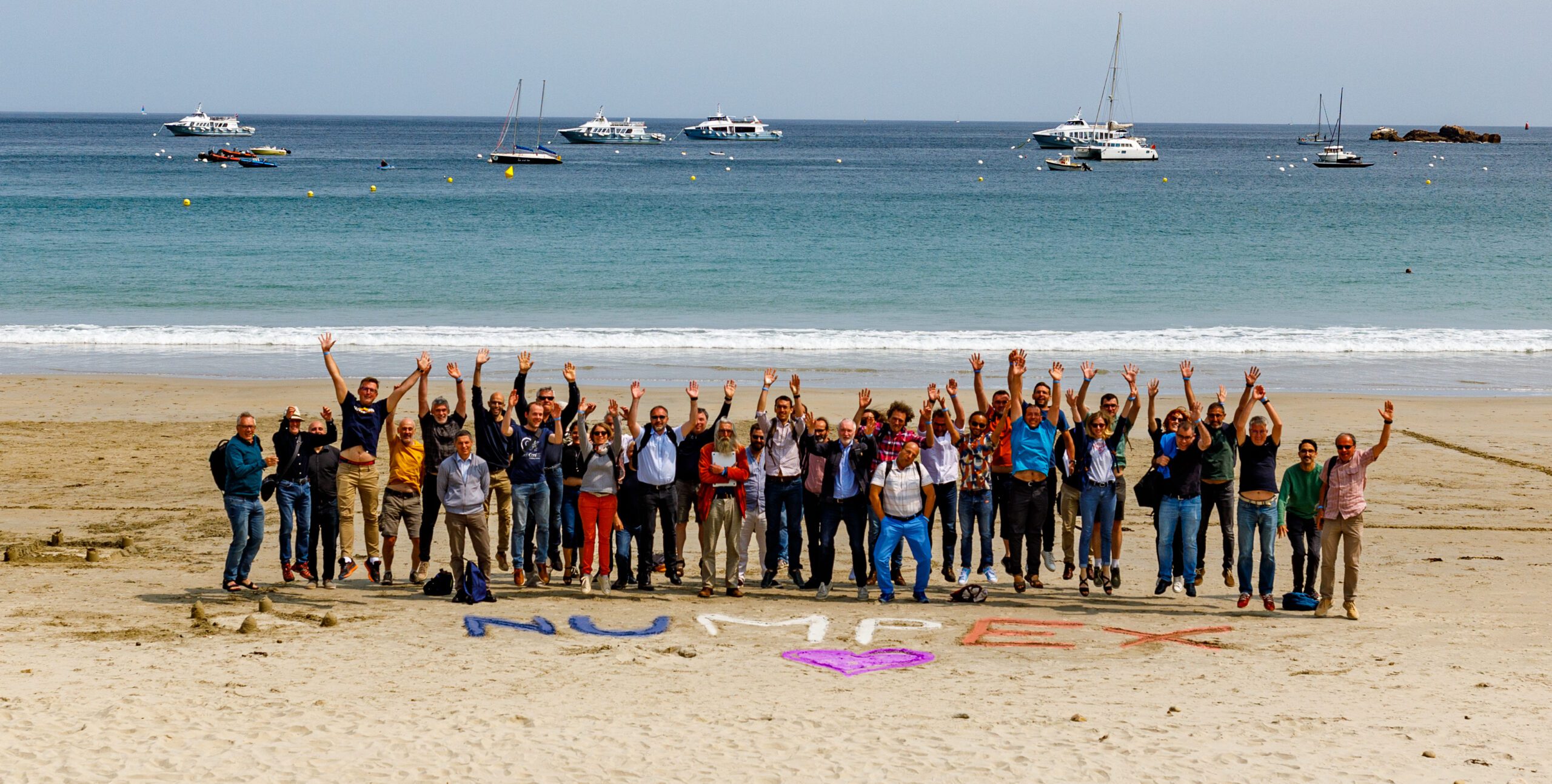The 2025 Exa-DoST general assembly
The 2025 Exa-DoST Annual Assembly took place from 5 to 7 November, 2025, bringing together 65 researchers and engineers from academia and industry to discuss the latest progress, prepare the milestones of the work packages, and welcome the latest recruits.
Exa-DoST (Data-oriented Software and Tools for the Exascale) is one of the five projects of the NumPEx program. Exa-DoST will address the major data challenges by proposing operational solutions co-designed and validated in French and European applications. This will allow filling the gap left by previous international projects to ensure that French and European needs are taken into account in the roadmaps for building the data-oriented Exascale software stack.
Finally, Exa-DoST was proud to welcome its new recruits, who rose brilliantly to the challenge of presenting scientific highlights in plenary sessions and via poster sessions!
Wednesday, 5 November 2025
- An introduction or refresher to NumPEx and Exa-DoST
by Gabriel Antoniu, Inria research scientist and Exa-DoST co-leader
and Julien Bigot, CEA research scientist and Exa-DoST co-leader - A few introductory words for everyone
by Gabriel Antoniu and Julien Bigot - First results and 2 scientific focuses for the workpackages:
- WP1 – I/O and data storage
by Francieli Boito, Inria research scientist and Exa-DoST WP leader
and François Tessier, Inria research scientist and Exa-DoST WP leader - WP2 – In situ data processing
by Yushan Wang, CEA research scientist and Exa-DoST WP leader
and Laurent Colombet, CEA research scientist and Exa-DoST WP leader - WP3 – ML-based data analytics
by Thomas Moreau, Inria research scientist and Exa-DoST WP leader
and Bruno Raffin, Inria research scientist and Exa-DoST WP leader - WP4:
by Virginie Grandgirard, CEA research scientist and Exa-DoST WP leader
and Damien Gratadour, Université Paris Cité professor and Exa-DoST WP leader
- WP1 – I/O and data storage
Thursday, 6 November 2025
-
Talk by François Mazen, Kitware
-
Talk by Xavier Delaruelle, TGCC
- Breakout sessions:
- Feedback on Gysela x WP1
Led by Virginie Grandgirard, Francieli Boito and François Tessier - Feedback on SKA x WP2
Led by Damien Gratadour and Yushan Wang, with the participation of Shan Mignot - Feedback on other apps (Coddex, Dyablo…) x WP3
Led by Laurent Colombet, Thomas Moreau and Brunon Raffin - Feedback on Gysela x WP2
Virginie Grandgirard, Yushan Wang and Laurent Colombet - Feedback on SKA x WP3
Led by Damien Gratadour, Thomas Moreau and Bruno Raffin - Feedback on other apps (Coddex, Dyablo…) x WP1
Led by Laurent Colombet, Francieli Boito and François Tessier
- Feedback on Gysela x WP1
Friday , 7 November 2025
-
Introduction to the last round of breakout sessions
by Julien Bigot - Breakout sessions:
- Feedback on Gysela x WP3
Led by Virginie Grandgirard, Thomas Moreau and Bruno Raffin - Feedback on SKA x WP1
Led by Damien Gratadour, Francieli Boito and François Tessier - Feeback on others apps (Coddex, Dyablo…) x WP2
Led by Laurent Colombet and Yushan Wang
- Feedback on Gysela x WP3
- Breakout sessions summary with all workpackages:
Attendees
- Mahamat Abdraman, Inria
- Jean-Thomas Acquaviva, DDN
- Gabriel Antoniu, Inria
- Julian AURIAC, CEA
- Rosa Maria Badia, BSC
- Alexis Bandet, Inria
- Iheb Becher, CNRS
- Mansour Benbakoura, Inria
- Andres Bermeo Marinelli, Inria
- Julien Bigot, CEA
- Jérôme Bobin, CEA
- François Bodin, Irisa
- Francieli Boito, Université de Bordeaux
- Robin Boezennec, Inria
- Etienne Bonnassieux, Université de Bordeaux
- Eric Boyer, Genci
- Valérie Brenner, CEA
- Silvina Caino-Lores, Inria
- Franck Cappello, Argonne National Laboratory, Online
- Pierre Cesar, Inria
- Jérôme Charousset, CEA
- Mathieu Cloirec, CINES
- Arnaud Collioud, Université de Bordeaux
- Laurent Colombet, CEA
- Marwane Dalal, Laboratoire d’Astrophysique de Bordeaux
- Ariel De Vora, CEA
- Xavier Delaruelle, CEA
- Arnaud Durocher, CEA
- Sofya Dymchenko, Inria
- Hugo Gaquere, Observatoire de Paris
- Virginie Grandgirard, CEA
- Damien Gratadour, Université Paris Cité
- Amina Guermouche, Inria
- Gabriel Hautreux, CINES, Online
- Hadrien Hendrikx, Inria
- Arthur Jaquard, Inria
- Théo Jolivel, Inria
- Sylvain Joube, CEA
- Ivan LUCAS, CEA
- Jakob Luettgau, Inria
- Martial Mancip, CEA
- Benoit Martin, CEA
- François Mazen, Kitware
- Yann Meurdesoif, CEA
- Shan Mignot, CNRS
- Thomas Moreau, Inria
- Jacques Morice, CEA
- Étienne Ndamlabin, Inria
- Guillaume Pallez, Inria
- Lucas Pernollet, CEA
- Abhishek Purandare, Inria
- Bruno Raffin, Inria
- Olivier Richard, Université Grenoble Alpes
- Kento Sato, Riken
- Hugo Strappazzon, Inria
- Frédéric Suter, Oak Ridge National Laboratory, Online
- François Tessier, Inria
- Samuel Thibault, Université de Bordeaux
- Luan Teylo, Inria
- Alix Tremodeux, ENS Lyon
- Méline Trochon, Inria
- Hippolyte Verninas, Inria
- Sunrise Wang, CNRS
- Yushan Wang, CEA
- Jad Yehya, Inria
©Martial Mancip / PEPR NumPEx
Storing massive amounts of data: better understanding for better design and optimisation
Find all the information about Exa-DoST here.
A understanding of how scientific applications read and write data is key to designing storage systems that truly meet HPC needs. Fine-grained I/O characterization helps guide both optimization strategies and the architecture of future storage infrastructures.
Data is at the heart of scientific applications, whether it be input data or processing results. For several years, data management (reading and writing, also known as I/O) has been a barrier to the large-scale deployment of these applications. In order to design more efficient storage systems capable of absorbing and optimising this I/O, it is essential to understand how applications read and write data.
Thanks to the various tools and methods we have developed, we are able to produce a detailed characterisation of the I/O behaviour of scientific applications. For example, based on supercomputer execution data, we can show that less than a quarter of applications perform regular (periodic) accesses, or that concurrent accesses to the main storage system are less common than expected.
This type of result is decisive in several respects. For example, it allows us to propose I/O optimisation methods that respond to clearly identified application behaviours. Such characterisation is also a concrete element that influences the design choices of future storage systems, always with the aim of meeting the needs of scientific applications.

Figure: Step of data classification.
© PEPR NumPEx
How well do we really understand the temporal I/O behavior of HPC applications — and why does it matter?
Read the extended version of this paper “A Deep Look Into the Temporal I/O Behavior of HPC Applications” here
Exa-DoST is proud to share its new publication at IPDPS 2025: A Deep Look Into the Temporal I/O Behavior of HPC Applications.
In collaboration between Inria (France), TU Darmstadt (Germany), and LNCC (Brazil), Francieli Boito, Luan Teylo, Mihail Popov, Theo Jolivel, François Tessier, Jakob Luettgau, Julien Monniot, Ahmad Tarraf, André Carneiro, and Carla Osthoff present a large-scale study of temporal I/O behavior in high-performance computing (HPC), based on more than 440,000 traces collected over 11 years from four large HPC systems.
Understanding temporal I/O behavior is critical to improving the performance of HPC applications, particularly as the gap between compute and I/O speeds continues to widen. Many existing techniques—such as burst buffer allocation, I/O scheduling, and batch job coordination—depend on assumptions about this behavior. This work examines fundamental questions about the temporality, periodicity, and concurrency of I/O behavior in real-world workloads. By analyzing traces from both system and application perspectives, we provide a detailed characterization of how HPC applications interact with the I/O subsystem over time.
Key contributions include:
- A classification of recurring temporal I/O patterns across diverse workloads.
- Insights into I/O concurrency and shared resource usage.
- Public release of the used large datasets to support further research.
Our findings offer a solid empirical foundation for future developments in behavior-aware monitoring, I/O scheduling, and performance modeling.
Read the full version on HAL.
Photo credit Francieli Boito
The 2024 annual meeting of Exa-DoST
The second annual meeting of the NumPEx Exa-DoST project took place at Inria, in Rennes, on 18-19 September 2024. This two days were an opportunity to share the first outcomes of the projet and discuss the upcoming research.
The Exa-DoST project is one of the five targeted projects of the NumPEx program, focusing on the challenges posed by data storage, processing, and analytics in the context of the emergence of Exascale Computing in Europe. The goal is to leverage innovative storage technologies and support complex hybrid workflows involving simulation, analytics, and learning, running at extreme scales across supercomputers interconnected to Clouds and Edge-based systems.
The second annual meeting of the Exa-DoST project took place at Inria, in Rennes, on 18-19 September 2024. It gathered participants in the project (scientists, engineers, students) with the goal of providing a common, shared vision on the project’s objectives, activities, and strategy. It also included specific workshops focused on identifying challenging application requirements in terms of data storage and analytics. For the first time, members of the ExaDoST Scientific Advisory Committee and of the Industrial and Technology Advisory Committee attended a global Exa-DoST meeting.
Wednesday, 18 September 2024
The first day was dedicated to presentations providing an overview of the project’s goals and activities in the various specific areas covered by the technical work packages. These were followed by a discussion on how the activities performed in these work packages (WP) could interact together.
-
- Introduction to NumPEx and Exa-DoST
by Gabriel Antoniu, Inria research scientist and Exa-DoST co-leader
and Julien Bigot, CEA research scientist and Exa-DoST co-leader - Goals and progress status of the work packages:
- WP1 – Storage and I/O
by Francieli Boito, Inria research scientist and Exa-DoST WP leader
and François Tessier, Inria research scientist and Exa-DoST WP leader - WP2 – In situ processing
By Yushan Wang, CEA research scientist and Exa-DoST WP leader
and Laurent Colombet, CEA research scientist and Exa-DoST WP leader - WP3 – ML-based analytics
by Thomas Moreau, Inria research scientist and Exa-DoST WP leader
and Bruno Raffin, Inria research scientist and Exa-DoST WP leader - WP4 – Application illustrator :
by Virginie Grandgirard, CEA research scientist and Exa-DoST WP leader
and Damien Gratadour, Université Paris Cité professor and Exa-DoST WP leader
- WP1 – Storage and I/O
- Introduction to NumPEx and Exa-DoST
- Session on inter-WP interaction
animated by Gabriel Antoniu and Julien Bigot
Thursday, 19 September 2024
-
- Introduction to the parallel brainstorming sessions
by Julien Bigot - Session on Codex
by Laurent Colombet - Session on Gysela
by Virginie Grandgirard - Session on SKA
by Laurent Colombet
- Introduction to the parallel brainstorming sessions
The participants found the exchanges particularly fruitful and decided to continue this work through a series of online and physical meetings.
Attendees
- Gabriel Antoniu, Inria and Exa-DoST leader
- Rosa Badia, BSC and board member of Exa-DoST
- Thomas Badts, Inria
- Andres Bermeo Marinelli, Inria and member of Exa-DoST
- Julien Bigot, CEA and Exa-DoST leader
- Francieli Boito, Inria and Exa-DoST WP leader
- Silvina Caino-Lores, Inria and member of Exa-DoST
- Damien Chapon, CEA and member of Exa-DoST
- Laurent Colombet, CEA and Exa-DoST WP leader
- Almuhisen Feda, CEA and member of Exa-DoST
- Chiara Ferrari, Observatoire de la Côte d’Azur and Board member of Exa-DoST
- Virginie Grandgirard, CEA and Exa-DoST WP leader
- Damien Gratadour, Université Paris Cité and Exa-DoST WP leader
- Gabriel Hautreux, CINES and board member of Exa-DoST
- Nicolas Lardjane, CEA and board member of Exa-DoST
- Pierre-François Lavallée, CNRS and board member of Exa-DoST
- Jakob Luettgau, Inria and member of Exa-DoST
- Benoit Martin, CEA and member of Exa-DoST
- François Mazen, Kitware and board member of Exa-DoST
- Yann Meurdesoif, CEA and board member of Exa-DoST
- Dorian Midou, CEA and member of Exa-DoST
- Shan Mignot, CNRS and member of Exa-DoST
- Julien Monniot, Inria and member of Exa-DoST
- Thomas Moreau, Inria and Exa-DoST WP leader
- Sai Narasimhamurthy, ParTec and board member of Exa-DoST
- Etienne Ndamlabin, Inria and member of Exa-DoST
- Jean-Francois Nezan, INSA
- Thomas Noël, ANR and Exa-DoST point of contact
- Kevin Obrejan, CEA and member of Exa-DoST
- Guillaume Pallez, Inria and member of Exa-DoST
- Lucas Pernollet, CEA and project manager of NumPEx
- Cédric Prigent, Inria and member of Exa-DoST
- Abhishek Purandare, Inria and member of Exa-DoST
- Bruno Raffin, Inria and Exa-DoST WP leader
- Stéphane Requena, Genci and board member of Exa-DoST
- Kento Sato, Riken and board member of Exa-DoST
- Frederic Suter, CNRS and board member of Exa-DoST
- François Tessier, Inria and Exa-DoST WP leader
- Sunrise Wang, Observatoire de la Côte d’Azur
- Yushan Wang, CEA and Exa-DoST WP leader
© Lucas Pernollet
Unleashing the Power of Exascale Computing: Genci's 2022 Activity Report
We are thrilled to present the highly anticipated activity report of Genci for the year 2022.
As a leading organization responsible for providing powerful computational and data processing resources, Genci has been instrumental in driving scientific research and innovation at both the national and European levels.
With a mission to promote the use of supercomputing coupled with artificial intelligence, Genci has made significant strides in benefitting scientific research communities, academia, and industrial sectors. Join us as we explore the remarkable achievements showcased in this 68-page report.

Launching Innovative Programs and Initiatives:
Genci’s commitment to pushing the boundaries of computational capabilities is evident through the launch of several groundbreaking programs and initiatives. The report highlights key projects, such as:
- NumPEx: The NumPEx initiative aims to harness the power of supercomputing and AI to drive scientific progress. By providing researchers with cutting-edge computational resources, Genci enables them to tackle complex challenges across various scientific domains.
- Jules Verne Consortium for Exascale: Genci’s partnership in the Jules Verne Consortium demonstrates their dedication to advancing exascale computing. This collaboration fosters innovation and propels research in areas that were once unimaginable.
- CLUSSTER Project: The CLUSSTER project focuses on integrating cloud computing solutions into Genci’s infrastructure. By embracing the cloud, Genci enhances flexibility and scalability, enabling researchers to tackle data-intensive workloads with ease.
- New Supercomputer “Adastra”: Genci’s introduction of the state-of-the-art supercomputer “Adastra” marks a significant milestone. With its remarkable computational power, Adastra empowers researchers to tackle complex simulations, accelerate data analysis, and drive scientific breakthroughs.
Driving Quantum Computing Advancements:
Genci recognizes the immense potential of quantum computing and has made significant progress in this field. The report highlights notable achievements, including:
- National Hybrid Quantum Computing Platform: Genci has played a pivotal role in launching of this platform. This initiative fosters collaboration and enables researchers to explore the capabilities of quantum computing in solving real-world problems.
- Integration of Quantum Systems: Genci has acquired its first quantum systems, marking a significant step towards enabling researchers to harness the power of quantum computing. These systems pave the way for groundbreaking research and innovation in quantum-enabled applications.
- The Quantum Package: Genci’s Quantum Package (PAck Quantique) provides researchers with the necessary tools and resources to explore hybrid quantum computing systems. This initiative promotes the development of novel algorithms and applications that bridge classical and quantum computing.
Advancements in Artificial Intelligence:
Genci has embraced the transformative potential of artificial intelligence, as highlighted in the report:
Bloom Model: Genci’s Bloom Model showcases their efforts to develop cutting-edge AI algorithms and frameworks. By combining supercomputing with AI, Genci facilitates breakthrough research in machine learning, deep learning, and data analytics.
Contributing to Scientific Research and Industry:
Genci is dedicated to supporting scientific research communities, academia, and industrial sectors through different initiatives, as exemplified by their efforts in:
- Reusing Waste Heat: Genci’s innovative approach includes the valorization of waste heat generated by the Jean Zay supercomputer. This environmentally friendly initiative showcases Genci’s dedication to sustainability and efficient resource utilization.
- Grands Challenges: Genci actively supports researchers in tackling grand challenges, providing them with the computational resources needed to address complex problems across diverse scientific disciplines.
- Exemplary Simulations: The report presents compelling examples of simulations conducted with Genci’s resources, showcasing the impactful discoveries and advancements made possible through their support.
- Community of Large Industrial Groups: Genci’s collaboration with large industrial groups highlights their commitment to bridging the gap between academia and industry. By fostering partnerships, Genci facilitates the transfer of cutting-edge research and technological advancements into real-world applications.
Genci’s Regional and European Ecosystem:
The report highlights Genci’s active involvement in regional and European initiatives:
- Regional Initiatives: Genci actively contributes to regional development through initiatives like SiMSEO, Competence Center, and MesoNet. These programs encourage cooperation among research institutions and industries, which promotes innovation and contributes to economic growth..
- European Collaborations: Genci’s participation in European collaborations, such as PRACE, EuroHPC, EUPEX, and EPI SGA, underscores their commitment to establishing a strong European ecosystem for high-performance computing. These collaborations facilitate knowledge exchange, resource sharing, and foster a vibrant European research community.
The 2022 Activity Report by Genci demonstrates their commitment to empowering scientific research and driving innovation by integrating exascale computing, artificial intelligence, and quantum computing.
Through the launch of groundbreaking programs, the introduction of cutting-edge technologies, and collaborations with research communities and industry, Genci has made significant contributions to advancing scientific frontiers.
Their commitment to sustainable practices and regional and European partnerships further solidifies their position as a leading provider of computational resources.
As we look to the future, Genci continues to pave the way for transformative discoveries and breakthroughs in scientific research and technological innovation.
NumPEx Launches into Action with an Ambitious Kick-Off Agenda in Perros-Guirrec
In a series of dynamic sessions hosted from June 26th to 28th in the charming town of Perros-Guirrec, NumPEx embarked on an intensive kick-off event, setting the stage for a transformative journey in Exascale computing. Leaders, experts, and collaborators convened to delve into an agenda rich with insights,workshops, and collaborative initiatives.

The kick-off began with a comprehensive introduction, outlining the objectives and significance of the NumPEx program, aiming to establish a common vision and foster collaboration to implement a coherent software stack and related processes by 2025, benefiting not only France but also Europe, in preparation for the Exascale machine. Key figures such as Jerome Bobin, Michel Dayde, and Jean-Yves Berthou elaborated on the program's goals and organizational structure. Board members shared their perspectives on the Exascale vision and roadmaps:
GENCI's Exascale Vision and Roadmap:
- Presentation of GENCI's role and missions, including hosting the Exascale project for EuroHPC.
- European HPC initiative partnership with EuroHPC and others, leveraging PRACE and GEANT.
- Introduction of the Jules Verne consortium, highlighting international and industrial partnerships.
- Vision of the European Exascale machine: addressing societal challenges, fostering innovation, and emphasizing HPC/IA data-centric convergence.
- Collaboration plans with NumPEx, including building a functional program, benchmark development, and product promotion.
Eviden Exascale Vision and Roadmap:
- Eviden's complex approach involving HPC, HPDA, IA, and quantum technologies with a focus on sovereign and European components.
- Involvement in the European integrated processor for Exascale machines (SiPearl) and collaborations with various technology projects.
- Collaboration with CEPP for application support and participation in technology projects related to Exascale, quantum, cloud, and more.
National and European Ecosystem:
- Introduction of EUPEX, a 4-year project with a budget similar to NumPEx, aiming to deploy a modular Exascale system using the OpenSequana architecture.
- Collaboration with NumPEx, potential for shared experiments and results, and exploration of common dissemination.
- Presentation of Data Direct Network (DDN) with a focus on AI and Lustre parallel file system, highlighting challenges and the importance of understanding NumPEx applications.
The afternoon continued with a tour of the five projects (PCs) within the NumPEx program:
- Exa-MA, which aims to design scalable algorithms and numerical methods for forthcoming exascale machines. Led by Christophe Prudhomme (Université de Strasbourg) and Helene Barucq (Inria).
- Exa-Soft, to develop a coherent, portable, efficient, and resilient software stack for exascale. Led by Raymond Namyst (Inria) and Alfredo Buttari (CNRS - Centre national de la recherche scientifique).
- Exa-DoST, to overcome challenges relating to data, notably storage, I/O, in situ processing, and smart analytics, in exascale supercomputers. Led by Gabriel Antoniu (Inria) and Julien Bigot (CEA).
- Exa-ATOW, to deal with large-scale workflows involving exascale machines. Led by François Bodin (Université de Rennes), Mark Asch (Université de Picardie Jules Verne (UPJV)), and Thierry Deutsch (CEA).
- Exa-DI, to ensure transverse co-design and software productivity for exascale supercomputers. Led by Jean-Pierre Vilotte (CNRS) and Valérie Brenner (CEA).
The day concluded with an emphasis on the collaborative efforts between NumPEx and other initiatives, with a focus on benchmark development, software-hardware links, and the overall goal of preparing for the challenges of the Exascale era.
The second day kicked off with an invigorating early morning jog along the seashore, setting a vibrant tone for a day filled with thematic workshops. Participants engaged in focused discussions on energy synergies, GPU integration, applications, co-design, gender/diversity/equity, software production integration, training, resilience, international collaborations, and artificial intelligence. Thematic workshops, led by domain experts, fostered collaboration within smaller groups, emphasizing the program's commitment to a transverse approach to Exascale challenges.
The final day commenced with a synthesis of workshop outcomes, highlighting the depth of discussions within each thematic area. Workshop leaders consolidated insights, offering a panoramic view of challenges and opportunities. Here is an overview of the key insights and strategic actions discussed during these workshops:
GPU Accelerators Workshop
In a dedicated workshop on GPU Accelerators, experts emphasized the pivotal role of Graphics Processing Units (GPUs) in achieving exascale computing. With 90-99% of large machine performance attributed to GPU acceleration, the workshop highlighted the need for applications to explore the potential of these powerful processors. Challenges discussed included new programming paradigms, code portability, data management, and the hardware landscape driven by gaming and artificial intelligence. The workshop outlined a comprehensive plan, including future workshops, analysis papers, tutorials, hackathons, and examples of successfully ported mini-apps.
Energy Workshop
The Energy Workshop focused on achieving Exascale computing within a power consumption limit of 20MW. Experts delved into environmental, scientific, technical, and societal dimensions, providing a roadmap for the HPC community. Key challenges identified included modeling system consumption, real-time measurement tools, resource prioritization based on societal impact, and the broader environmental impact of research activities. The action plan involves developing a performance and consumption model, optimization strategies, tools for users, and fostering links with external entities to incorporate energy considerations.
Gender Equity and Diversity Seminar
The action plan includes the establishment of a Code of Conduct, assessment of gender distribution, creation of a web platform for resources, education and training initiatives, awareness and outreach programs, and dedication to accessibility and recognition. NumPEx aims to create an inclusive and collaborative future, inviting all stakeholders to contribute to the initiatives.
AI Workshop
The AI Workshop explored the critical intersection of HPC and AI, addressing challenges and outlining a strategic plan for collaborative exploration. Key discussions included decision support tools for AI applications in HPC, optimizing runtimes for AI models, and converging HPC and AI usages. The action plan involves establishing an AI Working Group, conducting transversal workshops, and developing fundamental building blocks for a convergent future.
Training Strategies Workshop
The Training Strategies Workshop addressed the complexities of training in the context of the impending exascale era. Discussions included the scope and subjects of training programs, the creation of sustainable training models, and economic considerations in training initiatives. The workshop emphasized collaborative and inclusive training initiatives to prepare the scientific community for the challenges and opportunities of exascale computing.
International Collaborations Workshop
The International Collaborations Workshop focused on identifying challenges and setting objectives for enhanced collaborative frameworks on a European and global scale. Discussions covered scientific and technological challenges, the design and development of the exascale software stack, and strategic action plans. The outlined roadmap includes hosting workshops, exchanging insights and experiences, and strengthening collaborations with international entities.
National Centers Integration Workshop
The National Centers Integration Workshop aimed to align NumPEx with HPC infrastructures, emphasizing operational elements between computing centers and NumPEx 's targeted projects. Discussions covered operational assessment, cybersecurity, job profiling, and traceability. The workshop set a plan for regular video conferences, ensuring ongoing communication and collaboration.
Software Production Workshop
The Software Production Workshop focused on streamlining software development practices in the HPC domain. Challenges discussed included bridging silos, enforcing good practices, and amplifying impact. Insights and conclusions highlighted diverse development practices, sustainability models, and the deployment of continuous integration and certification. NumPEx 's commitment to advancing software production practices aims to foster innovation, collaboration, and sustainable development in HPC.
Exascale Resilience Workshop
The Exascale Resilience Workshop navigated complexities associated with exascale application deployment. Discussions covered diverse approaches across NumPEx PCs, key challenges, and strategic choices. The action plan involves listing and analyzing application needs, analyzing barriers to library adoption, and scrutinizing international solutions. NumPEx aims to foster collaborative solutions for enhanced application resilience at a global scale.
Applications and Co-Design Workshop
The Applications and Co-Design Workshop promoted co-development strategies for advanced application development. Discussions included challenges in co-design, key questions for collective exploration, building connections, and initiatives for sustainability. The workshop set the stage for upcoming co-development project workshops, emphasizing collaboration and innovation.

